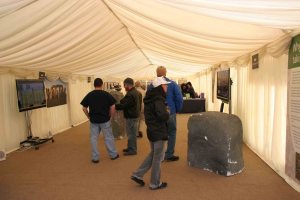So, 2008 sees Stonehenge undergoing a new series of excavations. A rare event indeed. Professors Wainwright and Darvill have been granted the opportunity to investigate a small area within the stone circle to gain a better understanding of the role and date of the bluestones – the earliest of the megaliths at Stonehenge, and the ones which appear to have been sourced from the Preseli Hills in west Wales, 150 miles away. The excavation is happening during the first two weeks of April, and is being filmed for BBC’s Timewatch programme, who are also keeping a nicely up-to-date website, and have broadcast several items on the regional and national news.
Visiting the site yesterday, the question that arose in my mind was less about the academic goals of the excavation, and more about the strength of the engagement with the visitors to the site. Stonehenge was fairly busy yesterday, helped no doubt by the recent TV coverage, and what was especially heartening was the level of conversation that these visitors were having – at least 60% were discussing archaeology and many of these were displaying a pretty good knowledge of the subject.
Sad it is to record therefore, that on this day English Heritage (the government agency charged with the site’s care and interpretation) had signally failed to grasp the opportunity to engage with this audience. Though a small interpretation ‘marquee’ had been erected to inform, this was poorly done and clearly an afterthought. Most of the tent was taken up with yet another shop and the only indication of what was occurring on the site was a pair of plasma screens, one of which was showing a live feed of the dig. Nowhere was there anyone around to interpret what was happening for visitors, and nowhere was there anyone from EH or the dig team engaging with their public.
The ‘Interpretation Centre’ at Stonehenge
Contrast this with the situation last year when EH were carrying out consolidation and conservation works on Silbury Hill, a Neolithic site about 25 miles north of Stonehenge. On this occasion, a small portakabin was set-up to display the latest results of the work, and staffed with people who were actually part of the dig team, and who were excited, enthused and most importantly communicative about their work.
At Stonehenge yesterday, there was a distinct sense of ‘them and us’, the public were reduced to peering at the dig from a long way away or standing in front of a screen in the interpretation centre, with no idea what was happening. The Stonehenge wardens didn’t seem to have much of an idea what was going on either.
As I sat down in the all-too-rare April sunshine to eat my lunch, it seemed a real shame that no EH staff were there to engage, inform and turn-on what would have been an already receptive audience. What could a little imagination have done here? What would have happened if this site was in America? With a little more thought, we might have had dig team members sitting down with the public during their picnics, talking about the latest finds, or perhaps by bringing the barriers a little closer we might have been able to see the dig itself. The wardens all seemed pretty miserable, and were clearly not in the loop – couldn’t it have been part of their role to inform the public?
There is a tremendous appetite for history and archaeology in this country. Television viewing figures, attendances at historic sites, and on other learning opportunities have never been higher, and its vital that agencies such as EH engage effectively with this audience if they are to secure their own future.
What it seems to me was happening yesterday was that all the planning and resources dedicated for public engagement had been expended on producing TV slots, websites and other non-personal resources. What people really want is personal interaction, the opportunity to talk with experts, and understand the work of those whose privilege it is to dig at Stonehenge.
Digital and broadcast resources are great, but no substitute for true, physical engagement.


Hi,
This is an interesting topic, you may be aware that within the archaeological world there exists a concept of ‘commercial archaeology’. It’s a label or tag used normally within academia to identify the domain where consultants and archaeological contactors operate, an ultimately to identify the hard working an often poorly paid ‘diggers’. What you have identified is the reciprocal, the world of the heritage industry, one that feeds very well off this work, and where the real commercial interests lie. Commercial should be applied to this domain, and, dare I say it to the notion that it’s OK to offer ever more degrees in the subject (no financial implications there are I guess?) to youngsters the majority of whom have little prospect of ever finding realistically paid employment. It doesn’t take a genius to work out what kind of money sites like Stonehenge, with its hundreds of thousand of paying visitors a year generate in hard cash, and compare it with the sorry state of affairs reflected in the visitors ‘Stonehenge Experience’. Not long ago I would have held back on these views, for we were promised a new vision, road improvements and visitor centre, now all ‘too expensive’ it seems. I wish you the best of luck with your pages; it would be really good to see a big open forum on the Heritage Industry and what it really offers the public.
By: sarsen56 on 9 April, 2008
at 12:11 pm